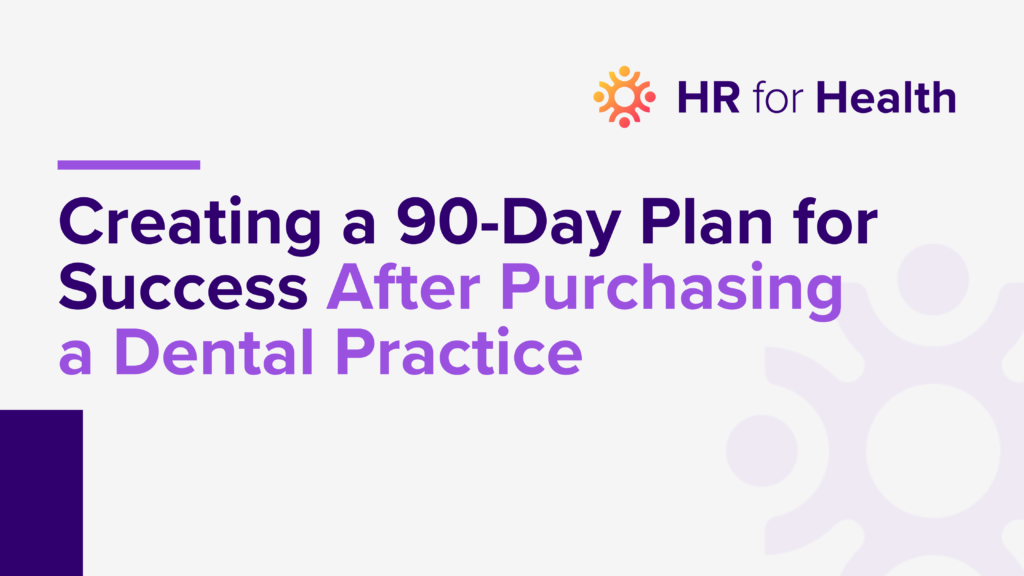Purchasing a dental practice is a significant investment and a crucial step towards fulfilling your professional dreams. However, the transition can be challenging without a solid plan. A well-structured 90-day plan is essential to ensure a smooth transition, establish clear goals, and set the foundation for long-term success. In this blog post, we’ll outline key steps to create a successful 90-day plan and explore how HR for Health software can support your journey.
Why a 90-Day Plan is Crucial
A 90-day plan provides a clear roadmap for the initial phase after acquiring a dental practice. It helps you:
- Understand the Practice: Gain insights into the existing operations, staff, and patient base.
- Set Priorities: Identify immediate actions needed to stabilize and improve the practice.
- Establish Goals: Define short-term and long-term objectives to guide your actions.
- Build Relationships: Foster trust and collaboration with staff and patients.
- Monitor Progress: Track achievements and adjust strategies as needed.
Steps to Create a 90-Day Plan
- Pre-Transition Preparation
- Due Diligence: Before finalizing the purchase, conduct thorough due diligence to understand the practice’s financial health, patient demographics, and operational processes.
- Develop a Vision: Define your vision for the practice. Consider how you want to shape the patient experience, staff culture, and service offerings.
- Set Initial Goals: Establish specific, measurable, achievable, relevant, and time-bound (SMART) goals for the first 90 days.
- First 30 Days: Assessment and Stabilization
- Meet the Team: Introduce yourself to the staff. Hold individual meetings to understand their roles, strengths, and concerns.
- Evaluate Operations: Assess the current operational processes, including scheduling, billing, and patient flow.
- Review Financials: Analyze the financial performance of the practice. Identify areas for improvement in revenue cycle management.
- Patient Communication: Announce the change in ownership to patients. Reassure them of continuity in care and introduce any immediate improvements.
- Days 31-60: Implementing Changes
- Operational Improvements: Start implementing changes to streamline operations. Focus on areas like scheduling efficiency, inventory management, and patient record keeping.
- Training and Development: Provide training sessions for staff on new protocols, technologies, and customer service standards.
- Marketing Initiatives: Launch marketing campaigns to retain existing patients and attract new ones. Highlight any new services or improvements you’ve made.
- Engage with Patients: Actively seek patient feedback through surveys and direct conversations to understand their needs and expectations.
- Days 61-90: Consolidation and Growth
- Monitor Progress: Review the progress of implemented changes. Use data and feedback to make necessary adjustments.
- Enhance Services: Introduce new services or technologies that align with your vision for the practice.
- Strengthen Relationships: Continue building strong relationships with staff and patients. Recognize and reward staff contributions.
- Plan for the Future: Develop a strategic plan for the next year, focusing on growth, patient satisfaction, and operational excellence.
How HR for Health Software Can Help
HR for Health software is an invaluable tool in ensuring the success of your 90-day plan. Here’s how it can support each phase of your transition:
- Streamlined Onboarding
- Customizable Onboarding Checklists: HR for Health offers customizable checklists to streamline the onboarding process for new staff members, ensuring they understand their roles and responsibilities.
- Automated Paperwork: Simplify administrative tasks by automating paperwork, including employment contracts, tax forms, and direct deposit information.
- Performance Management
- Goal Setting and Tracking: Set and track SMART goals for your staff. Monitor progress and provide regular feedback to ensure alignment with your practice’s objectives.
- Performance Reviews: Conduct structured performance reviews using HR for Health’s performance management tools. Document feedback and create development plans to enhance staff performance.
- Training and Development
- Certification Tracking: Keep track of staff certifications and continuing education requirements to ensure compliance with industry standards.
- Compliance and Risk Management
- Policy Management: Create, distribute, and track compliance with practice policies. Ensure all staff are aware of and adhere to relevant regulations.
- Incident Reporting: Maintain a secure system for reporting and managing workplace incidents. HR for Health helps you track and resolve issues promptly.
Example 90-Day Plan
First 30 Days: Assessment and Stabilization
- Week 1-2:
- Meet with each staff member individually.
- Review existing operational processes.
- Announce ownership change to patients.
- Week 3-4:
- Analyze financial performance.
- Identify immediate operational improvements.
- Begin staff training on new protocols.
Days 31-60: Implementing Changes
- Week 5-6:
- Implement changes to scheduling and patient flow.
- Launch initial marketing campaign.
- Conduct patient satisfaction surveys.
- Week 7-8:
- Continue staff training and development.
- Start implementing feedback from patient surveys.
- Monitor financial performance for improvements.
Days 61-90: Consolidation and Growth
- Week 9-10:
- Introduce new services or technologies.
- Hold performance reviews with staff.
- Recognize and reward staff achievements.
- Week 11-12:
- Develop a strategic plan for the next year.
- Strengthen patient relationships through personalized communications.
- Finalize any remaining operational improvements.
Conclusion
Creating a comprehensive 90-day plan is crucial for the success of your newly acquired dental practice. By systematically assessing, stabilizing, implementing changes, and consolidating your efforts, you can ensure a smooth transition and set the foundation for long-term growth. Leveraging HR for Health software can streamline these processes, enhance performance management, and foster a positive work environment. With a clear plan and the right tools, you can achieve your vision for a thriving dental practice.
For more information on how HR for Health can support your dental practice, contact us today and discover how our comprehensive HR solutions can help you succeed.


